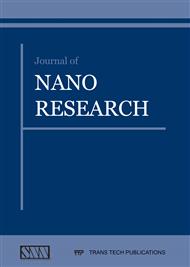p.142
p.155
p.164
p.175
p.185
p.193
p.199
p.208
p.218
Reduced Graphene Oxide Paper: Fabrication by a Green Thermal Reduction Method and Preliminary Study of its In Vitro Cytotoxicity
Abstract:
Graphene films have been intensively explored because of their unique mechanical and physicochemical properties for potential applications in field of tissue engineering and implants. However, for biomedical applications, it is necessary to fully understand the toxicity and biocompatibility of the prepared graphene films since different synthesis method might lead to different biological properties. Here we report a step-by-step thermal reduction method of preparing reduced graphene oxide (rGO) film directly on various substrates at low heating temperature (below about 200 °C) without requiring any chemical reduction agent like hydrazine or other reductants (therefore we call it green method). Slowly heating GO hydrosol that was coated on the surface of a glass cell-culture dish or inside of a polypropylene tube from room temperature to 60, 100, and 160 °C for 12 h, respectively, a shiny and flat surface without crumpled structure or tiny pores was formed. We peeled it off from the substrate to explore its cytotoxicity. The results exhibited that the rGO film was biocompatible with Cal-72 cell but against Escherichia coli bacteria. Our work confirmed that rGO film produced by the green reduction method is cytocompatible with mammalian cells, which makes this rGO film a promising material for tissue engineering scaffold or as a surface-modification coating of an implant.
Info:
Periodical:
Pages:
199-207
Citation:
Online since:
January 2017
Authors:
Price:
Сopyright:
© 2017 Trans Tech Publications Ltd. All Rights Reserved
Share:
Citation:


